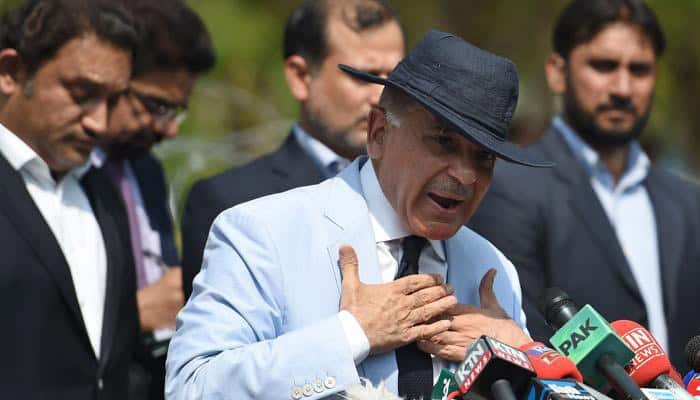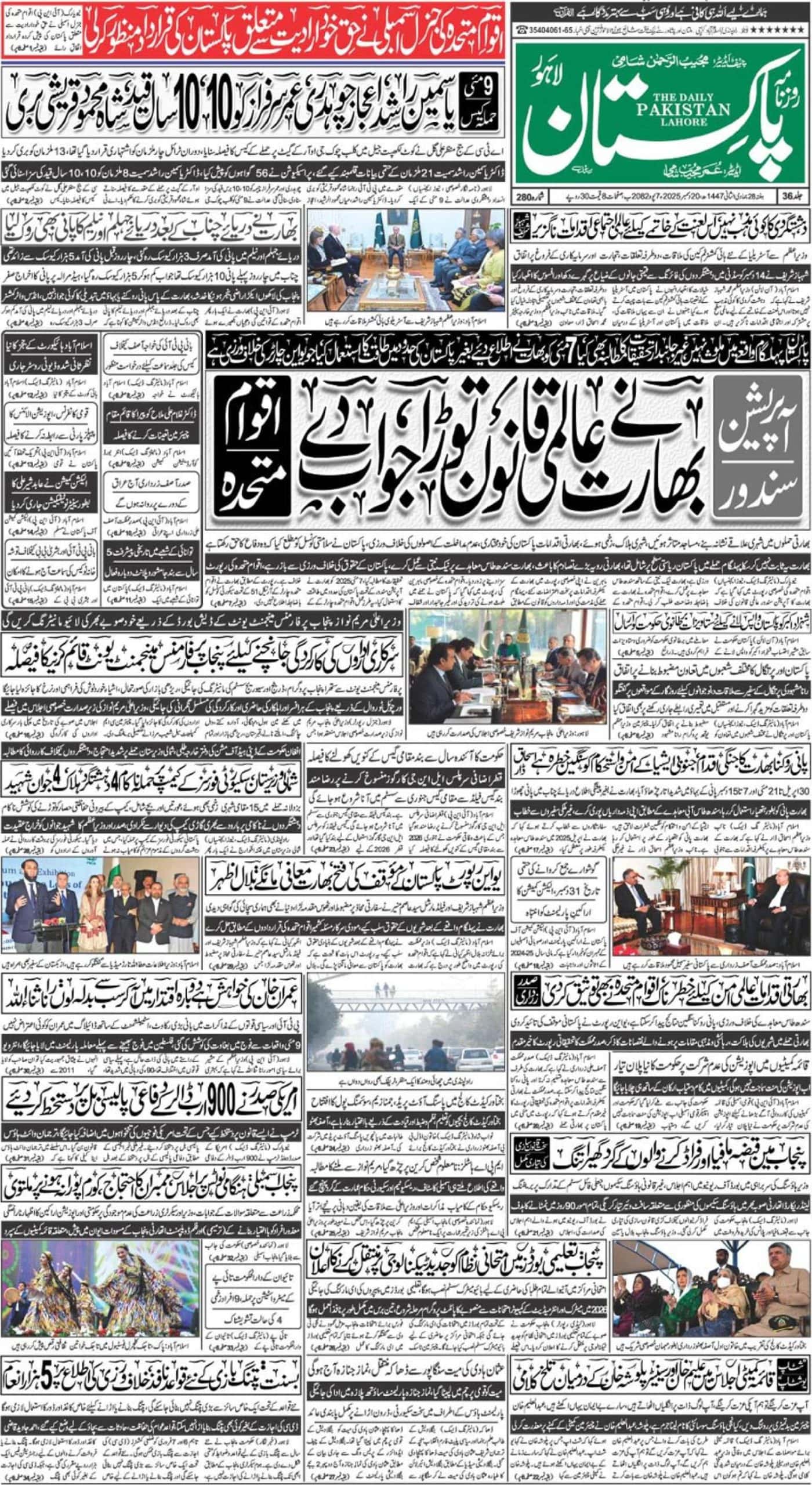Shahbaz Sharif and I go back a long way. His first stint as Punjab’s Chief Minister from 1997 to 1999 coincided with my tenure as Governor Punjab during these years. I resigned in August 1999 and was thus spared the humiliation of being escorted out of Government House by the military on the day of the unlawful coup, much hailed by the misguided and those who should have known better, against the constitutionally elected PML (N) Government.
Some months prior to the end of his tenure in May 2018, Shahbaz Sharif asked me to chair a Legal Reforms Committee to prepare proposals for improving governance in the Punjab Province. We jointly agreed on seven terms of reference. The Additional Chief Secretary was the Secretary of the Committee which included, amongst its members, a retired Judge of the Supreme Court, the Secretary Law, the Punjab Ombudsman, an Advocate of the Supreme Court, the Secretary Prosecution, the Secretary Local Government and two senior officers of the Chief Minister’s Secretariat. During the course of the Committee’s deliberations, I also co-opted the Senior Member Board of Revenue, the Finance Secretary and the Commissioner Lahore Division.
The Committee submitted its recommendations to the Chief Minister in March 2018. With some minor changes, the recommendations were approved at a meeting convened by the Chief Minister which also included the concerned Provincial Ministers. Initially, Shahbaz Sharif had hoped to implement the recommendations before he left office but could not do so on account of his ever-increasing involvement in issues relating to the imminent dissolution of the Provincial Assembly and his Government. The seven Committee Reports are now gathering dust in the cupboards of the Punjab Civil Secretariat. This is a pity. In the hope that the present Provincial Government may consider the implementation of the recommendations contained in these seven reports notwithstanding their association with Shahbaz Sharif and the previous PML-N Government, I have decided to make the recommendations public.
One of our term of reference was to suggest urgent measures for expediting the administration of justice. The Committee noted that the sanctioned strength of Judges in the Lahore High Court was 60. This number had been fixed by the President through a notification issued under Article 192 of the Constitution in August 2008. The number of Judges in the other three Provinces plus Islamabad was 78 including 40 in Sindh, 20 in KPK, 11 in Balochistan and 7 at Islamabad.
As, amongst other things, Punjab’s population was more than that of the three Provinces and Islamabad combined the number of High Court Judges in Punjab should be between 75 and 80. Apart from a population, there were other factors that more than justified the increase in the number of judges in the Lahore High Court including, in particular, the pendency of 140,000 cases. This pendency had not reduced to any significant extent during the last few years.
One of the reasons for non-reduction was that as against the sanctioned strength of 60 there were 12 vacant posts. The Committee recommended that the Provincial Government should request the Judicial Commission of Pakistan to fill the vacancies, as per Article 175-A of the Constitution, as soon as possible, and further that the Provincial Government should propose an increase in the number of Lahore High Court Judges from 60 to 75 (or 80) and undertake to provide the required funds accordingly in case this proposal was approved.
The Committee noted that there were about 12,00,000 cases pending in the Civil and District Courts of the Punjab. The total sanctioned strength of District and Session Judges, Additional District Judges, Senior Civil Judges and Civil Judges was 2364 of which 1770 were actually working while the remaining 594 posts were vacant. The Provincial Government should request the Chief Justice of the Lahore High Court to take steps for filling the vacancies as soon as possible. However, this by itself may not be enough. The Provincial Government should announce that despite resource constraints it was ready and willing to provide funds for another 216 Judges @ 6 per district in the 36 districts of the Punjab alongwith funds required for construction of additional court rooms to accommodate the extra numbers.
Some members had reservations about approving an increase in the numbers of the superior and subordinate judiciary till such time as the existing vacant posts had been filled.
The Provincial Government has already sent to the Lahore High Court for its views a draft law for the establishment of an Alternative Dispute Resolution System. The proposed law provides that at the very first hearing of a civil dispute, and even later at any stage of the proceedings, the Court can, with the consent of the parties, refer the matter for alternate dispute resolution either by arbitration or mediation or conciliation or evaluation by a neutral person.
The panel of neutral persons for each district is to be notified after consultation with the High Court and is to comprise advocates having at least 7 years active practice, retired or serving judges of the subordinate courts, retired civil servants, ulema, jurists, technocrats and other persons of repute and integrity having prescribed qualifications and experience. The draft law envisages the establishment of ADR centers in each district. The neutral persons are to resolve the dispute within 30 days, in the case of arbitration within 60 days. The settlements arrived at through the ADR proceedings are to be made decrees of the Court and will be executable accordingly.
There is to be no appeal or revision against such decrees as the process envisages that the settlements shall be arrived at with the mutual consent of the parties. In case of failure of the ADR proceedings to effect a settlement within 30 – 60 days period, the dispute is to be referred back to the Civil Court. After an extensive review of the draft law, the Committee recommended to the Provincial Government that it should take steps to enact the law as soon as it has received the views of the Lahore High Court. The Committee noted that a similar law had already been enacted by the Federal Government for the Islamabad Capital Territory. Implementation of this proposal will greatly reduce the pressure on the civil courts.
The Punjab Province has one Provincial Ombudsman based at Lahore. Although the Provincial Ombudsman has established reginal offices in the districts headed by retired officers of the rank of district or additional district judges or equivalent grades of the civil services these reginal offices are not empowered to pass final orders on complaints of maladministration processed by them. Their recommendations have to be sent for final orders to the Provincial Ombudsman.
The Committee noted that it would be eminently desirable if aggrieved persons were to be provided relief in the form of final orders passed by district ombudsmen who should be vested with powers similar, if not identical, with those exercised by the Provincial Ombudsman. The establishment of the district ombudsmen offices could be integrated with the office of the Provincial Ombudsman by providing for appeals to be heard and decided by the Provincial Ombudsman with the proviso that such appeals should be heard at divisional headquarters. A draft of the amending legislation was attached with the report sent to the Chief Minister. The draft law contains a schedule setting out the list of departments complaints against whom will be in the exclusive jurisdiction of the district ombudsmen. Establishment of district ombudsmen will vastly improve the access to justice of the common man. It will provide him with much cheaper and much quicker justice at his doorstep.
The Committee was firmly and unanimously of the view that all public functionaries must act in a fair, just and reasonable manner, that if a person was likely to be adversely affected by their decision he must be given an adequate opportunity to defend himself, that detailed reasons must be recorded for making any order likely to adversely affect any person and such person must immediately be provided a copy of the order. To achieve this end the Committee proposed insertion of Sections 19A and 24A in the Punjab General Clauses Act as under:-
“19A. Rules, Notifications, Orders and Regulations etc. to be published.- All rules, notifications, orders, regulations, bye-laws, schemes, forms, instructions and circulars having the force and effect of law and made or issued under any enactment shall be published in the official Gazette”.
“24A. Exercise of power under enactments.-(1) Where, by or under any enactment, a power to make any order or give any direction is conferred on any authority, office or person, such power shall be exercised reasonably, fairly, justly and for the advancement of the purposes of the enactment.
The authority, office or person making any order or issuing any direction under the powers conferred by or under any enactment shall, so far as necessary or appropriate in the circumstances of the case, give an opportunity of hearing to any person likely to be affected adversely, give reasons for making the order or for issuing the direction and shall provide a copy of the order or the direction to the person prejudicially affected”.
A draft of the amending law was sent to the Chief Minister. There can be little doubt that the proposed amendments will vastly improve the transparency, credibility and acceptability of executive orders. Further, adherence to the provisions of these amendments should substantially reduce the quantum of grievances against executive orders that find their way to the High Court and the civil courts. A similar provision already exists in the Federal General Clauses Act in the form of its section 24A.
The Committee was firmly of the view that the security situation in the rural areas of the Province, and re-establishment of the effective writ of the Provincial Government in the rural areas, required the revival of the lambardari and chowkidar systems. For the same reasons, there was a need to appoint municipal wardens in the urban areas.
There are about 18,000 sanctioned posts of chowkidars in the 9 divisions of the Province of which nearly 8,500 are vacant. Similarly, there are about 38,500 sanctioned posts of lambardars of which nearly 5,500 are vacant. With the advent of the Local Government system, the post of lambardar has lost its attraction except in the colony districts where, in terms of a notification issued in January 2006 under the Colonization of Government Lands Act 1912, about 500 lambardars hold grants of State Land. No such grants are available in the non-colony districts.
The lambardars (village headmen) are appointed under the Punjab Land Revenue Act 1967 and the Punjab Land Revenue Rules 1968 and their manifold duties include collection of land revenue and other provincial government dues, reports to the Tehsildars on all encroachments on roads and government properties, submission of information required by the Deputy Commissioners on transport matters, crop inspections, surveys and the like, report on breaches in canals and water courses and reports on outbreak of contagious diseases. Under the Punjab Law Act of 1872, they are also to supervise and control the village chowkidars in their jurisdiction and to liaise with the local police.
To encourage the revival of the lambardari system the Committee proposed that lambardars be exempted from payment of annual renewal fees for arms licenses, that all government departments should seek the assistance of the lambardars in implementation of departmental programmes and to associate them in price control committees, peace committees and food committees, that the SHOs should involve the lambardars and the village chokidars in all watch and ward duties, that revenue and irrigation authorities should give priority to lambardars in attestation of documents relating to land and irrigation water and that lambardars should also be made responsible for collection of abiana in areas served by the Punjab Irrigation and Drainage Authority.
The Committee further proposed that the notification issued in January 2006 for grants of State lands to lambardars in colony districts should be rescinded provided that such land should revert to Government after existing lambardars have ceased to hold office. For the future, a Village Officers Cess equal to 5% of land revenue should be levied on all land owners to compensate the lambardars for the performance of their duties as permissible under section 37 of the Punjab Land Revenue Act.
In regard to village chowkidars the Committee recommended that they should be appointed by the Assistant Commissioners of each sub-division on the nomination of the lambardars and after obtaining certificates of good character from the local SHO. There should be one chowkidar (watchman) for every 200 houses or shops. The chowkidars should be middle pass and fulfill the physical eligibility criteria fixed for police constables.
In large villages, there should be a head watchman for every five village watchmen. The village watchmen should be paid Rs.50/- per house or shop within his beat. Apart from watch and ward duties, the watchmen should be made responsible for recording all births and deaths and for giving particular care to the safety and well-being of unattended children. The guiding principle for them should be that they are the servants of the village community.
The Committee noted that the 1872 Act was being administered by the Home Department and the Land Revenue Act by the Board of Revenue with little co-ordination between the two. One department should administer both laws. The Committee drafted and sent to the Chief Minister draft Rules for implementation of the proposals relating to village watchmen.
On the same pattern as the case of village watchmen, the Committee noted that section 137 of the Punjab Local Government Act 2013 provided for appointment of municipal wardens but the same had not been activated. The Committee drafted and sent to the Chief Minister draft Rules for an appointment of municipal wardens setting out in extenso their duties and functions. As these wardens will be paid by the urban local councils the proposed activation will require a readjustment of the financial relationship of the urban local councils with the Provincial Government.
Not much more than 20% of the population have access to the justice system. Recognizing this huge lacunae sections 96 to 99 of the Punjab Local Government Act 2013 provided for the establishment of Panchayats and Musalihat Anjumans. To a large extent, the provisions were a repeat of similar provisions in the local government law of 2001 enacted in the Pervaiz Musharraf era.
The provisions in both laws have remained a dead letter notwithstanding an activation attempt in 2006 through notification of the Musalihat Anjuman (Constitution and Function) Rules. The Committee framed fresh Rules prescribing the appointment and functions of Panchayats and Musalihat Anjumans. The stress in these Rules is on the amicable settlement at the village or mohallah level through informal/flexible procedures. The Committee also proposed that an amendment be made in the 2013 law to reduce the number of Anjuman members from an unwieldy 9 to a more workable 5.
The final report of the Committee was on splitting the Lahore district into either two or four districts. As per the 2017 Census report Lahore district has a population in excess of 12 million. The average population of the other 35 districts is about 3 million. Both public convenience and requirements of better administrative control require that Lahore be split into either four or at least two districts. The split into two appears to be more feasible and certainly less expensive. The two could become four at some later stage. It may be noted however that the Police Department have already split Lahore into 4 regions each headed by a DIG.
A sub-committee headed by the Commissioner Lahore Division prepared a detailed plan for splitting Lahore into two or four districts which was approved in principle by the meeting chaired by Shahbaz Sharif for implementation after the General Elections 2018.














